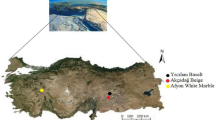Abstract
Mechanical properties of renal calculi dictate how a stone interacts and disintegrates by shock wave or intracorporeal lithotripsy techniques. Renal stones of different compositions have large variation in their mechanical strength and susceptibilities to shock waves. Operated urinary stones and artificially developed stones using pharmaceutical methods, composed of phosphates were subjected to tensile, flexural and compressive strength studies using universal testing machine. The infrared spectra confirmed the presence of hydroxyapatite in both the natural stones and struvite with calcium oxalate trihydrate in one stone and struvite with uric acid in the other. The X-ray diffraction analyses confirmed their crystalline nature. It has been observed that the flexural properties depend on the size of the sample even for the samples cut from a single stone. The compressive strengths were almost 25 times larger than the tensile strengths of the respective natural stones as well as the artificial stones prepared.















Similar content being viewed by others
References
Williams JC Jr, Zarse CA, Jackson ME et al (2006) Variability of protein content in calcium oxalate monohydrate stones. J Endourol 20(8):560–564. doi:10.1089/end.2006.20.560
Mohamed Ali A, Arunai Nambi Raj N, Kalainathan S et al (2008) Microhardness and acoustic behavior of calcium oxalate monohydrate urinary stone. Mater Lett 62(15):2351–2354. doi:10.1016/j.matlet.2007.11.093
Grases F, Costa-Bauza A, Garcia-Ferragut L (1998) Biopathological crystallization: a general view about the mechanisms of renal stone formation. Adv Colloid Interface Sci 74:169–194. doi:10.1016/S0001-8686(97)00041-9
Leusmann DB, Niggemann H, Roth S et al (1995) Recurrence rates and severity of urinary calculi. Scand J Urol Nephrol 29(3):279–283
Srinivasan S, Kalaiselvi P, Varalakshmi P (2006) Epitaxial deposition of calcium oxalate on uric acid rich stone matrix is induced by a 29 kDa protein. Clin Chim Acta 364:267–274. doi:10.1016/j.cca.2005.07.010
Xiang-bo Z, Zhi-ping W, Jian-min D et al (2005) New chemolysis for urological calcium phosphate calculi—a study in vitro. BMC Urol 5:9
Chaussy C, Schmiedt E, Jocham D et al (1982) First clinical experience with extracorporeally induced destruction of kidney stones by shock waves. J Urol 127:417–420
Mezentsev VA (2005) Extracorporeal shock wave lithotripsy in the treatment of renal pelvicalyceal stones in morbidly obese patients. Int Braz J Urol 31:105–110. doi:10.1590/S1677-55382005000200003
Cohen NP, Whitefield HN (1993) Mechanical testing of urinary calculi. World J Urol 11:13–18. doi:10.1007/BF00182165
Heimbach D, Munver R, Zhong P et al (2000) Acoustic and mechanical properties of artificial stones in comparison to natural kidney stones. J Urol 164:537–544. doi:10.1016/S0022-5347(05)67419-8
Zhong P, Chuong CJ, Preminger GM (1993) Characterization of fracture toughness of renal calculi using a microindentation technique. J Mater Sci Lett 12:1460–1462. doi:10.1007/BF00591608
Heimbach D, Jacobs D, Winter P et al (1997) Dissolution of artificial (natural) stones in a standard model: first results. J Endourol 11(1):63–66
Kerbl K, Rehman J, Landman J et al (2002) Current management of urolithiasis: progress or regress? J Endourol 16(5):281–288. doi:10.1089/089277902760102758
Lal B, Bamzai KK, Kotru PN (2002) Mechanical characteristics of melt grown doped KMgF3 crystals. Mater Chem Phys 78:202–207. doi:10.1016/S0254-0584(02)00342-5
Mohamed Ali A, Arunai Nambi Raj N, Kalainathan S et al (2006) Ultrasonic studies on artificial kidney stone models. J Pure Appl Ultrason 28(2–4):73–80
Coleman AJ, Saunders JE (1993) A review of the physical properties and biological effects of the high amplitude acoustic fields used in extracorporeal lithotripsy. Ultrasonics 31(2):75–89. doi:10.1016/0041-624X(93)90037-Z
Jan HR, Ladislav P, Daniel KA (2002) Factors of fragment retention after extracorporeal shockwave lithotripsy (ESWL). Br J Urol 28(1):3–9
Zhu S, Cocks FH, Preminger GM et al (2002) The role of stress waves and cavitation in stone comminution in shock wave lithotripsy. Ultrasound Med Biol 28:661–671. doi:10.1016/S0301-5629(02)00506-9
Visuri SR, Makarewicz AJ, London RA et al (2002) Laser and Acoustic Lens for Lithotripsy. US Patent 6,491,685 B2
Parr NJ, Pye SD, Tolley DA (1994) Comparison of the performance of two pulsed dye lasers using a synthetic stone model. J Urol 152:1619–1621
Jeremy LG, Diane SN, Eugene PL (1995) Self-reinforced composite poly(methy1methacrylate): static and fatigue properties. Biomoterials 16:1043–1055
Joshi VS, Joshi MJ (2003) FTIR spectroscopic, thermal and growth morphological studies of calcium hydrogen phosphate dihydrate crystals. Cryst Res Technol 38(9):817–821. doi:10.1002/crat.200310100
Ramachandran E, Natarajan S (2004) Crystal growth of some urinary stone constituents: III. In- vitro crystallization of L-cystine and its characterization. Cryst Res Technol 39(4):308–312. doi:10.1002/crat.200310187
Hesse A, Schneider HJ, Weitz G et al (1973) Magnesium ammonium phosphate monohydrate—a hitherto undetected constituent of urinary calculi. Int Urol Nephrol 5(1):19–26. doi:10.1007/BF02081748
Wang SJ, Yip MC, Hsu YS et al (2002) The modulus of toughness of urinary calculi. J Biomech Eng 124:133–134. doi:10.1115/1.1431264
Acknowledgments
The authors acknowledge the Managements of C. Abdul Hakeem College, Melvisharam and VIT University, Vellore for their encouragement and express their sincere thanks to Prof. Ganesh Gopalakrishnan, Christian Medical College and Hospital, Vellore and Dr. A. Manamalli, Institute of Biochemistry, Madras Medical College, Chennai and the authors also acknowledge University Grants Commission and Department of Science and Technology, Government of India for providing financial assistance.
Author information
Authors and Affiliations
Corresponding author
Additional information
This article directly relates to material presented at the 11th International Urolithiasis Symposium, Nice, 2–5 September 2008, from which the abstracts were published in the following issue of Urological Research: Urological Research (2008) 36:157–232. doi:10.1007/s00240-008-0145-5.
Rights and permissions
About this article
Cite this article
Mohamed Ali, A., Arunai Nambi Raj, N. Tensile, flexural and compressive strength studies on natural and artificial phosphate urinary stones. Urol Res 36, 289–295 (2008). https://doi.org/10.1007/s00240-008-0158-0
Received:
Accepted:
Published:
Issue Date:
DOI: https://doi.org/10.1007/s00240-008-0158-0




